Numerical Simulation of Sulfur Deposition in Wellbore of Sour-Gas Reservoir
Abstract
:1. Introduction
2. Wellbore Sulfur Deposition Prediction Model
2.1. Model Assumption
- (a)
- When the gas production flow velocity in the wellbore is greater than the critical sulfur carrying velocity, the precipitated sulfur does not deposit.
- (b)
- When the gas production flow velocity is less than the critical sulfur-carrying velocity, the precipitated liquid sulfur will fall to the bottom of the well, and the precipitated solid sulfur will adhere to the wellbore to form sulfur scale deposition.
- (c)
- The influence of differential pressure force, additional mass force, Bassett force, and Magnus force is ignored.
- (d)
- The liquid sulfur droplets are ellipsoid and solid sulfur particles are spheroids in the wellbore, and their morphology does not change during movement.
- (e)
- The flow in wellbore is one-dimensional, stable, and linear.
2.2. Sulfur Solubility
2.3. Critical Liquid Sulfur Carrying Velocity
2.4. Critical Solid Sulfur Carrying Velocity
2.5. Diffusion Deposition Model of Sulfur
3. Wellbore Pressure Model and Transient Temperature Model
3.1. Model Assumption
- (a)
- The fluid in the wellbore is a one-dimensional steady flow.
- (b)
- The change of physical property parameters, such as density during fluid flow, is considered.
- (c)
- Changes in wellbore diameter (except those due to sulfur deposition) are not considered, i.e., energy loss due to wellbore diameter change is not considered.
- (d)
- Formation temperature remains constant.
- (e)
- The effect of sulfur deposition on temperature distribution is considered in the wellbore transient temperature model.
- (f)
- The initial value of wellbore temperature distribution is given by the original formation temperature and geothermal gradient.
3.2. Wellbore Pressure Model
3.3. Wellbore Transient Temperature Model
4. Numerical Simulation of Sulfur Deposition in Sour-Gas Well
4.1. Model Solution
- (a)
- Divide the wellbore into several sections according to the wellbore trajectory, and input data, such as section length and deviation angle for each unit.
- (b)
- Input initial physical parameters.
- (c)
- Calculate the initial value of wellbore temperature distribution, Tini, by Equation (44). The initial value of wellbore pressure distribution, pini, can be obtained linearly from the initial bottomhole pressure to wellhead pressure.
- (d)
- Calculate the pressure of each section from the wellhead as the inlet end to obtain the wellbore pressure distribution, pcal. The specific calculation process is:
- a
- Calculate the sulfur solubility of the section i by Equation (2) to determine whether the sulfur is precipitated. If so (Cs > Co), determine whether the sulfur is deposited on the pipe wall according to the temperature conditions and gas flow velocity. If so (T > 119 °C and vgcr > vm), calculate the thickness of sulfur deposition and the wellbore diameter of the section i by Equations (24) and (25);
- b
- Calculate the fluid physical properties in section i considering sulfur precipitation;
- c
- Substitute the fluid physical properties into Equation (31) to calculate the initial value of the outlet pressure, pi,out, in section i;
- d
- Since the initial pressure value cannot meet the accuracy requirements, it cannot be determined whether its value is larger or smaller than the actual value. Based on the idea of numerical approximation, assign the average value of pi,in and pi,out to pi,in. Repeat steps a~c to get the revised value of the outlet pressure, pi,out’;
- e
- Compare the initial value, pi,out, and the revised value, pi,out’. If the error is greater than the allowable error, δ, assign pi,out’ to pi,out and repeat steps a~e;
- f
- If the error is smaller than δ, assign pi,out to pi+1,in and repeat steps a~f to get the wellbore pressure distribution, pcal.
- (e)
- Calculate the temperature of each section from the bottom of the well as the inlet end to obtain the wellbore temperature distribution, Tcal. The specific calculation process is:
- a.
- Calculate thermal physical parameters of section i;
- b.
- Substitute thermal physical parameters and pressure calculated by step (d) into Equation (43) to calculate the outlet temperature, Ti,out, in section i;
- c.
- Assign Ti,out to Ti+1. Repeat steps a~c to get the wellbore temperature distribution, Tcal.
- (f)
- Compare the initial values, Tini and pini, with the calculated values, Tcal and pcal. If the error is greater than the allowable error, δ, assign Tcal and pcal to Tini and pini, and repeat steps (d)~(f) until the required accuracy is reached.
- (g)
- Assign Tcal and pcal on day t to Tini and pini on day t + 1, and repeat steps (d)~(g) to get wellbore pressure and temperature distribution in different production times.
4.2. Model Validation
5. Results and Discussion
5.1. Model Application
5.2. Sensitivity Analysis
5.2.1. Production Time
5.2.2. Gas Production Rate
5.2.3. Wellbore Pressure
5.2.4. H2S Content
5.2.5. Well Trajectory
6. Conclusions
- (a)
- The wellbore sulfur deposition prediction model, pressure model, and transient temperature model considering the influence of different wellbore inclination angles were established. By coupling these models, the numerical simulation of sulfur deposition in the high-sulfur gas well was carried out. The average error between the calculated value and the measured value is 3.61%, indicating that the model has good calculation accuracy and engineering application value.
- (b)
- The proposed methodology was used to simulate four sour-gas wells in China, and the results show that sulfur deposition are not formed in these wells, but elemental sulfur is precipitated. The influence of wellbore inclination angle on critical sulfur-carrying velocity is analyzed, and the results show that the critical sulfur-carrying velocity increases first and then decreases with the increase of inclination angle, and the maximum critical sulfur-carrying velocity is about 20% larger than that of the vertical well section.
- (c)
- The effects of production time, gas production rate, wellbore pressure, H2S content, and well trajectory on wellbore sulfur deposition were analyzed. The results show that the wellbore sulfur deposition increases with the increase of production time and the decrease of wellbore pressure and decreases with the increase of gas production rate, H2S content, and inclination angle. Additionally, when gas production flow velocity exceeds the critical sulfur-carrying velocity, sulfur deposition will not occur in the wellbore.
- (d)
- The technological measures to control sulfur deposition and prevent sulfur plugging of wellbore were presented. a. Adjust production systems dynamically to avoid gas wells under the same production system for too long. b. Use a pre-cleaning process where sulfur plugging may occur. c. Keep the gas production flow velocity greater than the critical sulfur-carrying velocity as far as possible. d. In the middle and late stages of gas well production, the production dynamics should be observed carefully and the technical measures to prevent sulfur deposition in wellbore should be implemented closely. e. Use the well type with large inclination angle for production. In addition, heat and insulation measures should be applied to the wellbore.
Author Contributions
Funding
Institutional Review Board Statement
Informed Consent Statement
Data Availability Statement
Conflicts of Interest
Nomenclature
| Sulfur solubility of gas, kg/m3 | |
| Initial sulfur solubility, kg/m3 | |
| Instantaneous sulfur solubility, kg/m3 | |
| Natural gas density, kg/m3 | |
| Temperature, K | |
| Gravity, N | |
| Sulfur density, kg/m3 | |
| Sulfur volume, m3 | |
| Gravitational acceleration, m/s2 | |
| Buoyancy, N | |
| Sour-gas density, kg/m3 | |
| Drag force, N | |
| Drag coefficient | |
| Cross-sectional area of sulfur, m2 | |
| Sour-gas flow velocity, m/s | |
| Sulfur flow velocity, m/s | |
| Support force, N | |
| Complementary Angle of wellbore inclination angle, ° | |
| Friction, N | |
| Friction coefficient | |
| Critical sulfur-carrying velocity, m/s | |
| Height of the sulfur droplet, m | |
| Interfacial tension of sulfur droplets, N/m | |
| Critical Weber number | |
| Diameter of sulfur particle, m | |
| Reynolds number | |
| Wellbore diameter, m | |
| Sour-gas viscosity, Pa·s | |
| Transfer mass of sulfur, kg | |
| Mass transfer coefficient of sulfur, m/s | |
| Molecular weight of sulfur | |
| Mole content of sulfur in sour gas, mol/kg | |
| Equilibrium molarity of sulfur, mol/kg | |
| Mass transfer factor | |
| Smith number of gas flow | |
| Diffusion coefficient of sulfur in sour gas, m2/s | |
| Pressure, MPa | |
| Section length, m | |
| Wellbore circulation area, m2 | |
| External forces, N | |
| Amount of sulfur precipitated, kg/s | |
| Gas production rate, m3/s | |
| Enthalpy of sour gas, J/kg | |
| Mass flow rate of sour gas, kg/s | |
| Heat loss, J | |
| Specific heat of sour gas, J/(kg·K) | |
| Joule Thomson coefficient | |
| Temperature function from wellbore to formation | |
| Production time, s | |
| Distance from wellbore center, m | |
| Thermal conductivity of wellbore to formation, m2/s | |
| Heat transfer coefficient of wellbore to formation, W/(m·K) | |
| Heat capacity per unit volume of wellbore to formation, J/(m3·K) | |
| Distance of cement sheath outer wall to wellbore center, m | |
| Dimensionless time function | |
| Formation temperature, K | |
| Dimensionless time | |
| Total wellbore heat transfer coefficient without sulfur scale, W/(m·K) | |
| Distance of tubing outer wall to wellbore center, m | |
| Distance of tubing inner wall to wellbore center, m | |
| Sulfur scale thickness, m | |
| Wellbore temperature, K | |
| Geothermal gradient, K/m | |
| Bottomhole temperature, K |
References
- Hu, J.; Luo, W.; He, S.; Zhao, J.; Wang, X. Sulfur glomeration mechanism and critical velocity calculation in sour gas well bore. Procedia Environ. Sci. 2011, 11, 1177–1182. [Google Scholar]
- Roberts, B.E. Flow impairment by deposited sulfur-a review of 50 years of research. J. Nat. Gas Eng. 2017, 2, 84–105. [Google Scholar] [CrossRef]
- Chrastil, J. Solubility of solids and liquids in supercritical gases. J. Phys. Chem. 1982, 86, 3016–3021. [Google Scholar] [CrossRef]
- Roberts, B.E. The effect of sulfur deposition on gaswell inflow performance. SPE Reserv. Eng. 1997, 12, 118–123. [Google Scholar] [CrossRef]
- Eslamimanesh, A.; Mohammadi, A.H.; Richon, D. Determination of sulfur content of various gases using Chrastil-type equations. Ind. Eng. Chem. Res. 2011, 50, 7682–7687. [Google Scholar] [CrossRef]
- Hu, J.; Zhao, J.; Wang, L.; Meng, L.; Li, Y. Prediction model of elemental sulfur solubility in sour gas mixtures. J. Nat. Gas Sci. Eng. 2014, 18, 31–38. [Google Scholar] [CrossRef]
- Guo, X.; Wang, Q. A new prediction model of elemental sulfur solubility in sour gas mixtures. J. Nat. Gas Sci. Eng. 2016, 31, 98–107. [Google Scholar] [CrossRef]
- Amar, M.N. Modeling solubility of sulfur in pure hydrogen sulfide and sour gas mixtures using rigorous machine learning methods. Int. J. Hydrogen Energy 2020, 45, 33274–33287. [Google Scholar] [CrossRef]
- Wang, Y.; Luo, Z.; Gao, Y.; Kong, Y. Modeling the solubility of sulfur in sour gas mixtures using improved support vector machine methods. ACS Omega 2021, 6, 32987–32999. [Google Scholar] [CrossRef]
- Zhang, R.; Gu, S.; Huang, L.; Zeng, D.; Li, T.; Zhang, G. Experimental study on the elemental sulfur solubility in sour gas mixtures. Front. Earth Sci. 2021, 9, 931. [Google Scholar] [CrossRef]
- Abou-Kassem, J.H. Experimental and numerical modeling of sulfur plugging in carbonate reservoirs. J. Pet. Sci. Eng. 2000, 26, 91–103. [Google Scholar] [CrossRef]
- Al-Jaberi, J.; Al-Azani, K.; Fraim, M. Calculation of sulfur deposition in gas condensate wells in Middle East. In Proceedings of the SPE Kingdom of Saudi Arabia Annual Technical Symposium and Exhibition, Dammam, Saudi Arabia, 24–27 April 2017. [Google Scholar]
- Kuo, C.H.; Closmann, P.J. Theoretical study of fluid flow accompanied by solid precipitation in porous media. AIChE J. 1966, 12, 995–998. [Google Scholar] [CrossRef]
- Kuo, C.H. On the production of hydrogen sulfide-sulfur mixtures from deep formations. J. Pet. Technol. 1972, 24, 1142–1146. [Google Scholar] [CrossRef]
- Mahmoud, M.A.; Al-Majed, A.A. New model to predict formation damage due to sulfur deposition in sour gas wells. In Proceedings of the North Africa Technical Conference and Exhibition, Cairo, Egypt, 20 February 2012. [Google Scholar]
- Mahmoud, M.A. New Numerical and Analytical Models to Quantify the Near-Wellbore Damage due to Sulfur Deposition in Sour Gas Reservoirs. In Proceedings of the SPE Middle East Oil and Gas Show and Conference, Manama, Bahrain, 10 March 2013. [Google Scholar]
- Hu, J.; He, S.; Zhao, J.; Li, Y. Modeling of sulfur plugging in a sour gas reservoir. J. Nat. Gas Sci. Eng. 2013, 11, 18–22. [Google Scholar] [CrossRef]
- Hu, J.; Chen, Z.; Liu, P.; Liu, H. A comprehensive model for dynamic characteristic curves considering sulfur deposition in sour carbonate fractured gas reservoirs. J. Pet. Sci. Eng. 2018, 170, 643–654. [Google Scholar] [CrossRef]
- Qin, P.; Liu, J. Modeling sulfur plugging of fractured wells under non-Darcy and non-equilibrium sulfur deposition. J. Geophys. Eng. 2017, 14, 713–722. [Google Scholar] [CrossRef]
- Yang, Y.; Guo, X.; Wang, P. Modeling productivity of horizontal wells in a high sulfur gas reservoir: Consideration of the impact of porosity reduction by sulfur deposition. J. Eng. Res. 2018, 6, 1–22. [Google Scholar]
- Zou, C.; Wang, X.; Hu, J.; Lv, Y.; Fang, B.; Zhang, Y. A Novel Model for Predicting the Well Production in High-Sulfur-Content Gas Reservoirs. Geofluids 2021, 2021, 5529908. [Google Scholar] [CrossRef]
- Dou, L.; Li, G.; Shen, Z.; Song, X.; Chi, H.; Tao, D. Study on the Well Control Safety During Formation High-Sulfur Gas Invasion. In Proceedings of the IADC/SPE Asia Pacific Drilling Technology Conference and Exhibition, Tianjin, China, 9 July 2012. [Google Scholar]
- Liu, X.; Liu, L.; Yu, Z.; Zhang, L.; Zhou, L.; Zhang, Z.; Guo, F. Study on the coupling model of wellbore temperature and pressure during the production of high temperature and high pressure gas well. Energy Rep. 2022, 8, 1249–1257. [Google Scholar] [CrossRef]
- Tan, Y.; Li, H.; Zhou, X.; Wang, K.; Jiang, B.; Zhang, N. Inflow characteristics of horizontal wells in sulfur gas reservoirs: A comprehensive experimental investigation. Fuel 2019, 238, 267–274. [Google Scholar] [CrossRef]
- Haq, B. A Dynamic Workflow of Well Health Issue Prediction–Sulfur Deposition. In Proceedings of the International Petroleum Technology Conference, Virtual, 23–25 March 2021. [Google Scholar]
- Shao, M.; Yang, Q.; Zhou, B.; Dai, S.; Ahmad, F. Effect of Sulfur Deposition on the Horizontal Well Inflow Profile in the Heterogeneous Sulfur Gas Reservoir. ACS Omega 2021, 6, 5009–5018. [Google Scholar] [CrossRef]
- Liu, W.; Huang, X.; Zhang, L.; He, J.; Cen, X. Analysis of sulfur deposition for high-sulfur gas reservoirs. Pet. Sci. Technol. 2022, 40, 1716–1734. [Google Scholar] [CrossRef]
- Li, M.; Li, S.L.; Sun, L.T. New view on continuous-removal liquids from gas wells. SPE Prod. Facil. 2002, 17, 42–46. [Google Scholar] [CrossRef]
- Ford, J.T.; Peden, J.M.; Oyeneyin, M.B.; Gao, E.; Zarrough, R. Experimental investigation of drilled cuttings transport in inclined boreholes. In Proceedings of the SPE Annual Technical Conference and Exhibition, New Orleans, LA, USA, 23–26 September 1990. [Google Scholar]
- Barati, R.; Neyshabouri, S.A.A.S.; Ahmadi, G. Development of empirical models with high accuracy for estimation of drag coefficient of flow around a smooth sphere: An evolutionary approach. Powder Technol. 2014, 257, 11–19. [Google Scholar] [CrossRef]
- Hasan, A.R.; Kabir, C.S. Heat transfer during two-Phase flow in Wellbores; Part I—Formation temperature. In Proceedings of the SPE Annual Technical Conference and Exhibition, Dallas, TX, USA, 6–9 October 1991. [Google Scholar]
- Hasan, A.R.; Kabir, C.S. Aspects of wellbore heat transfer during two-phase flow. SPE Prod. Facil. 1994, 9, 211–216. [Google Scholar] [CrossRef]
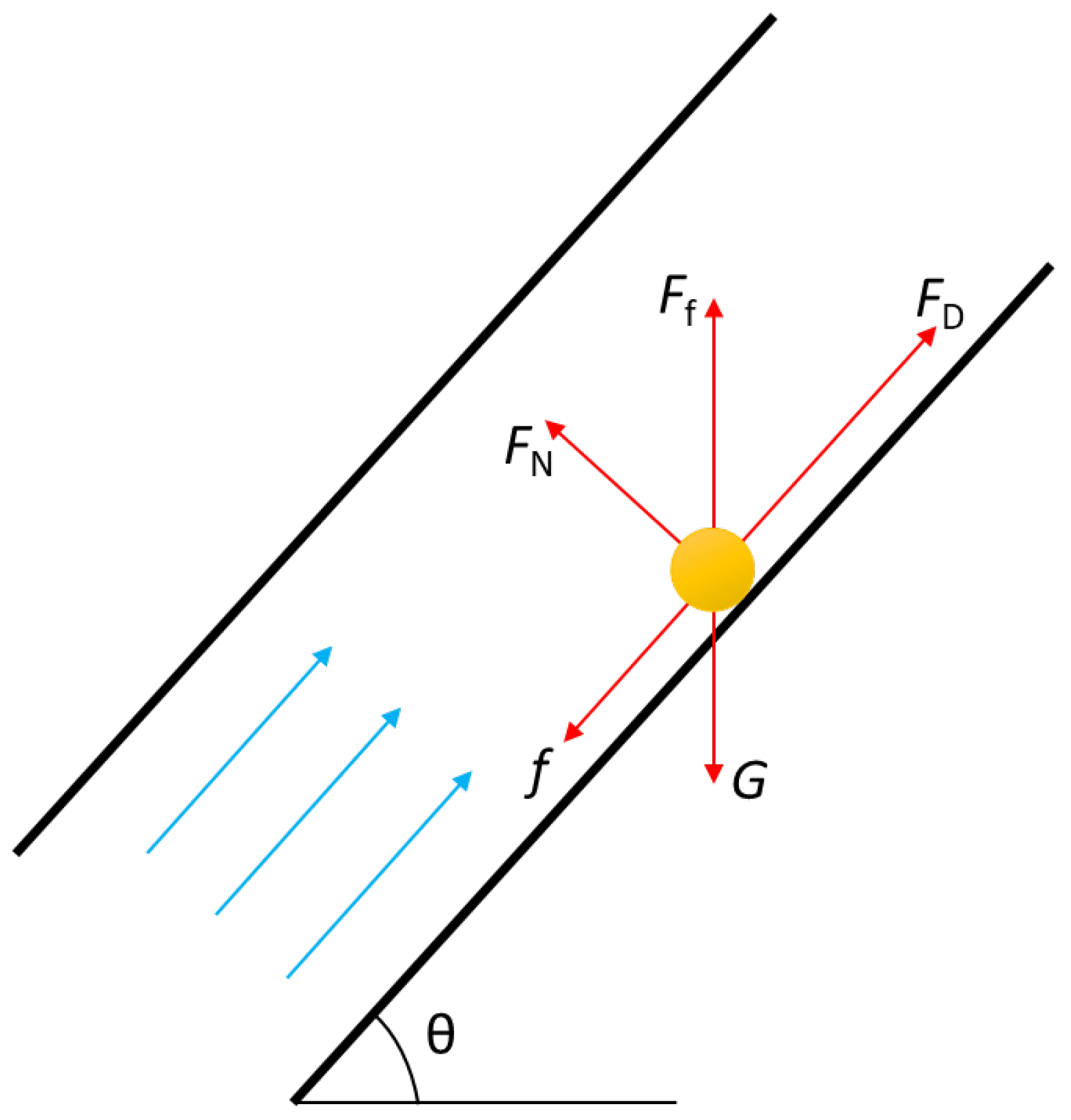

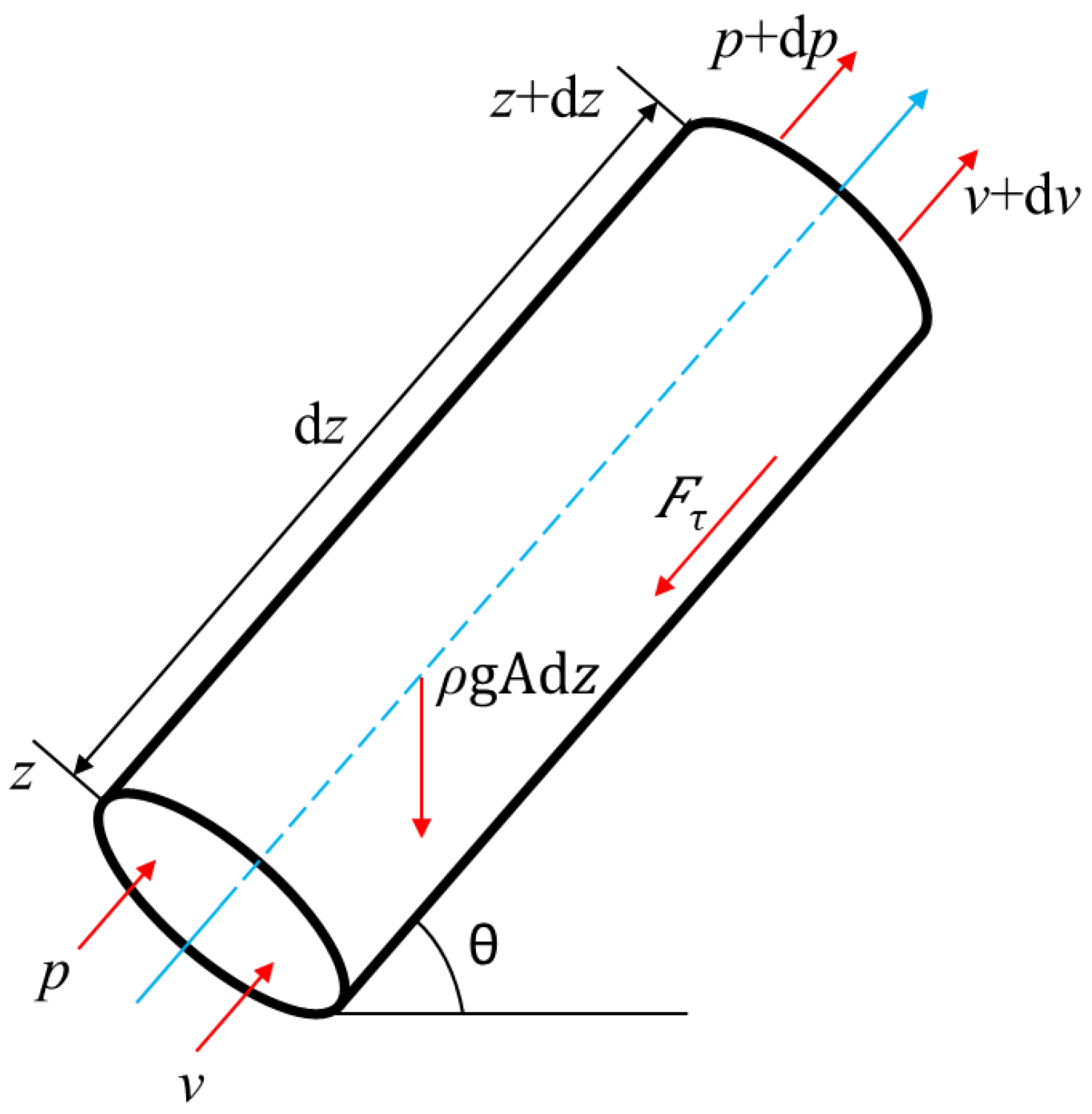

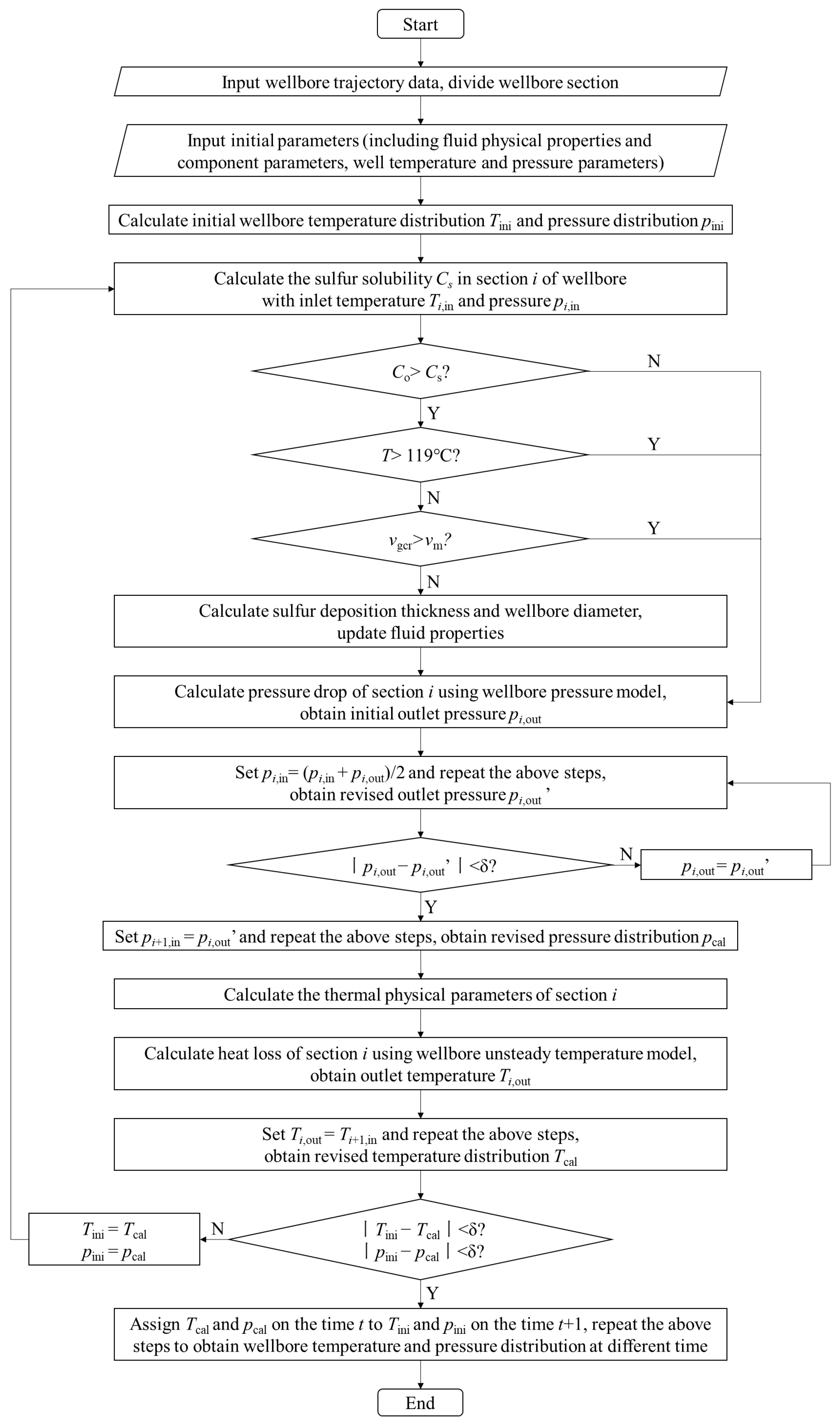
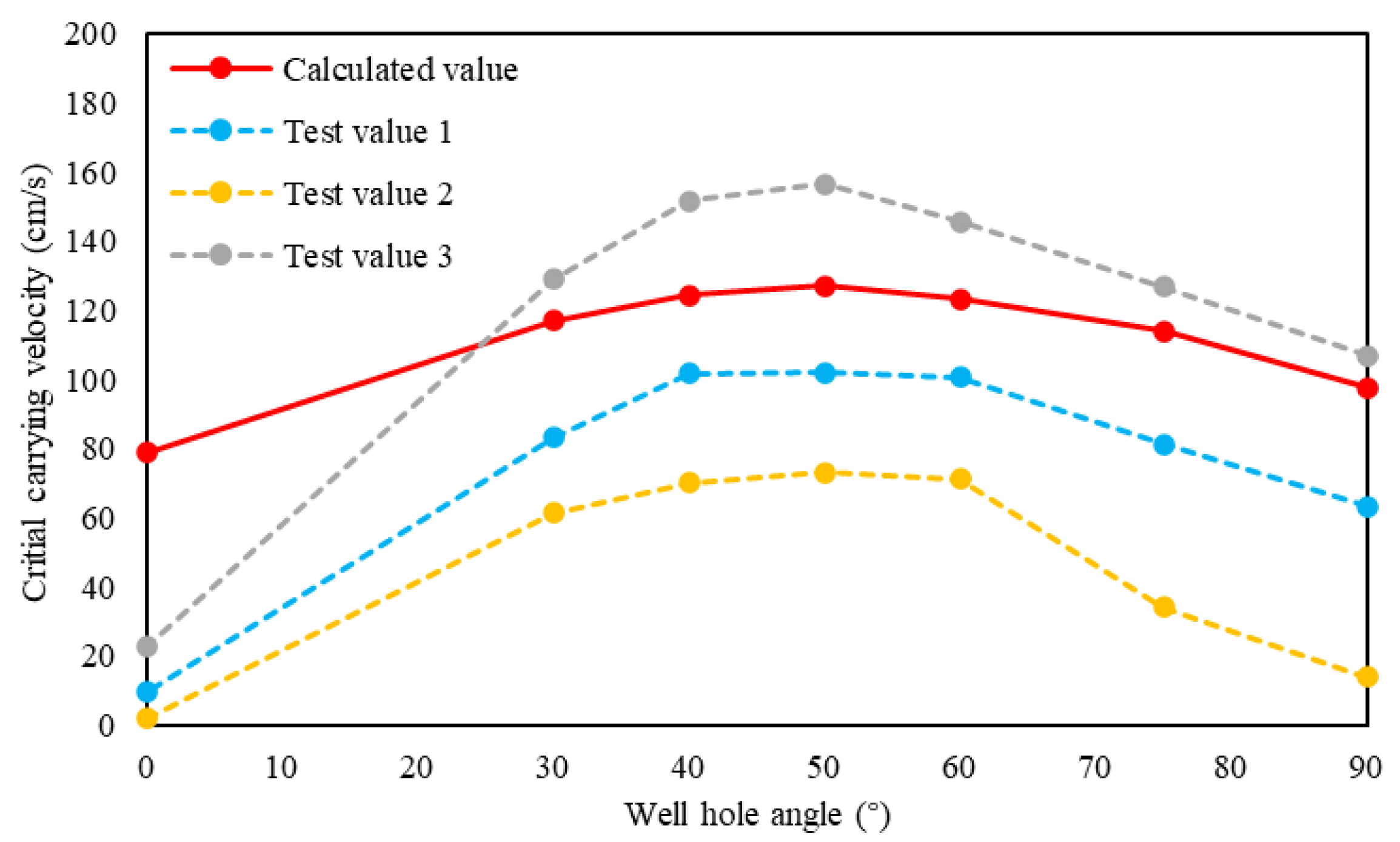

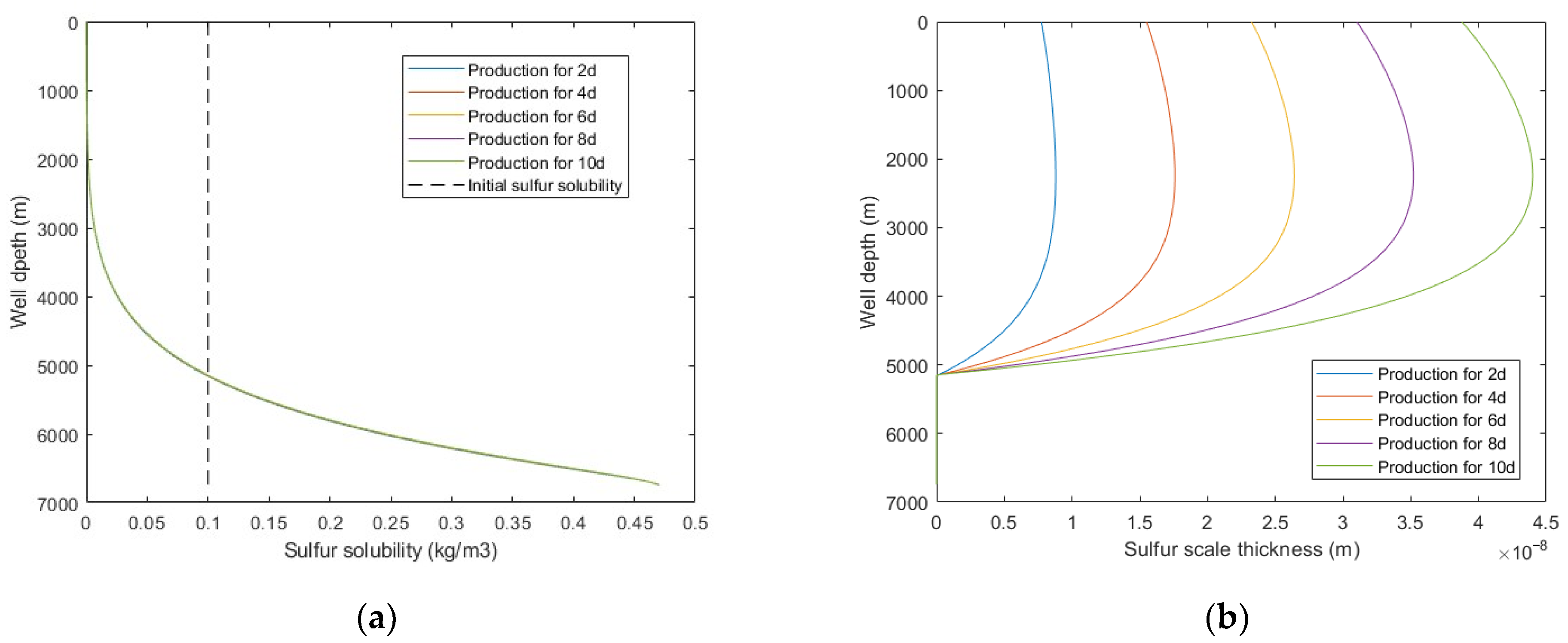

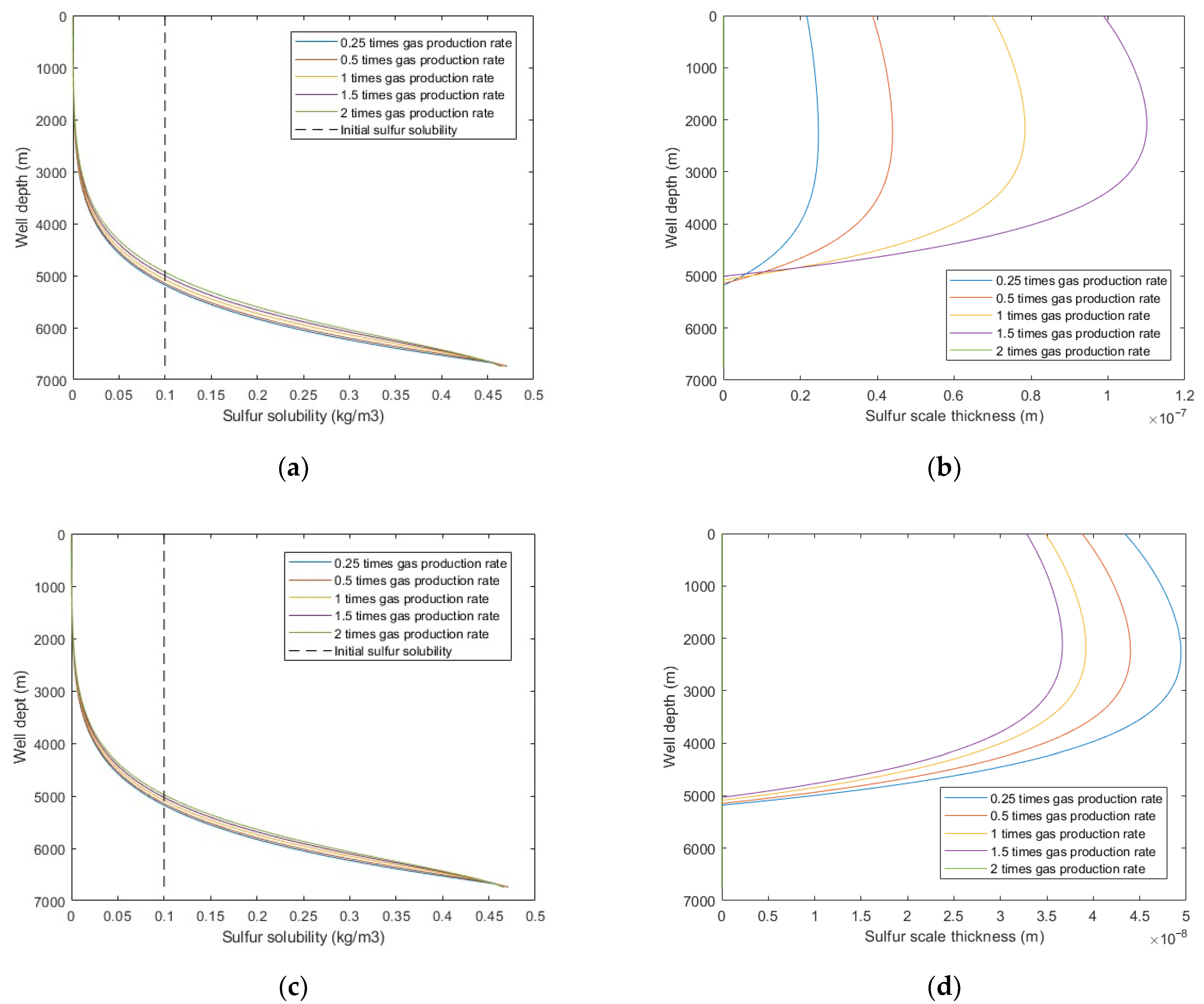
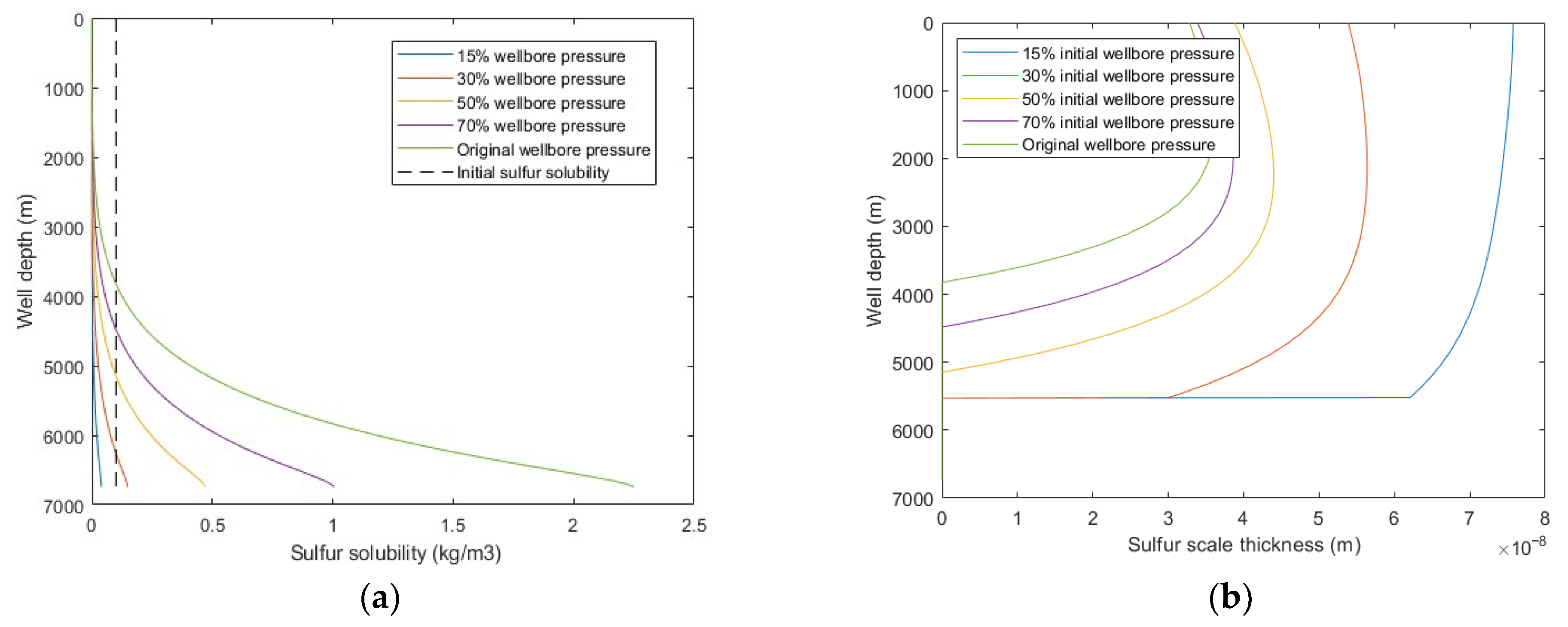

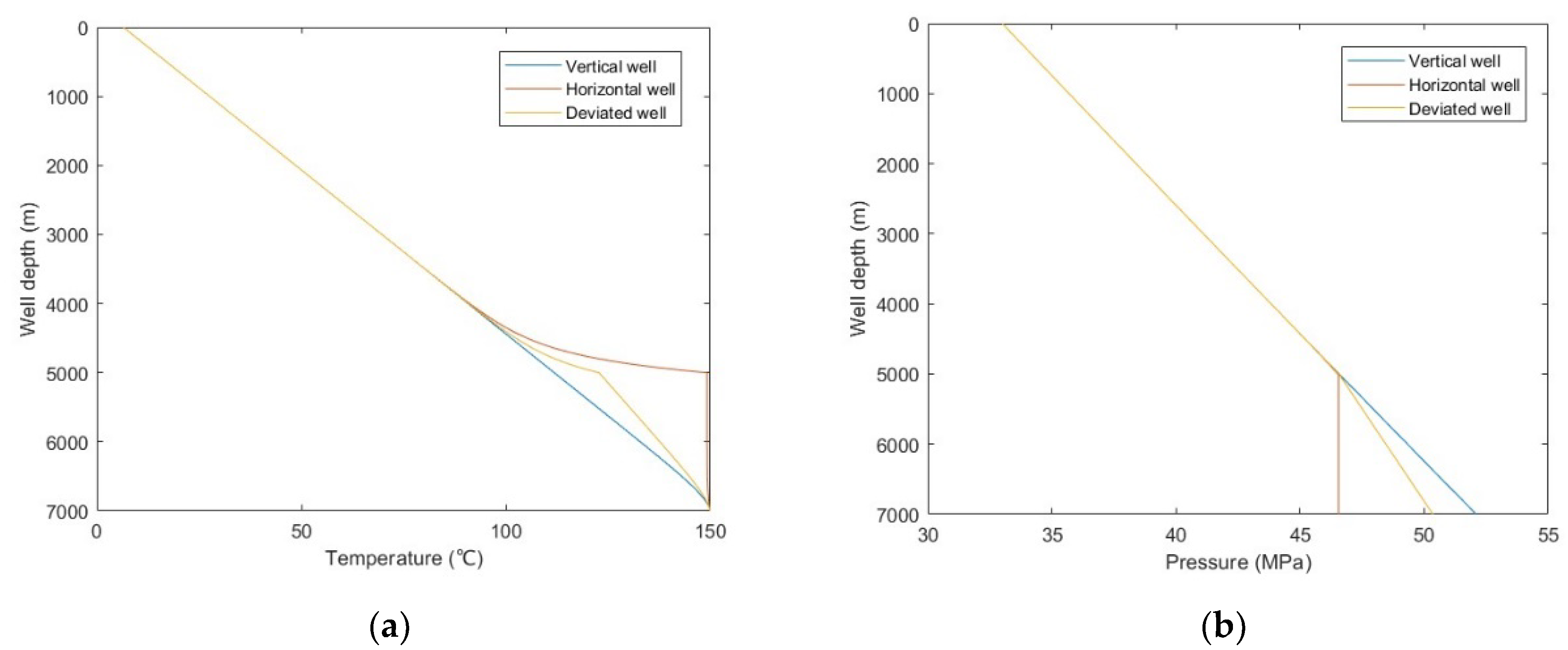
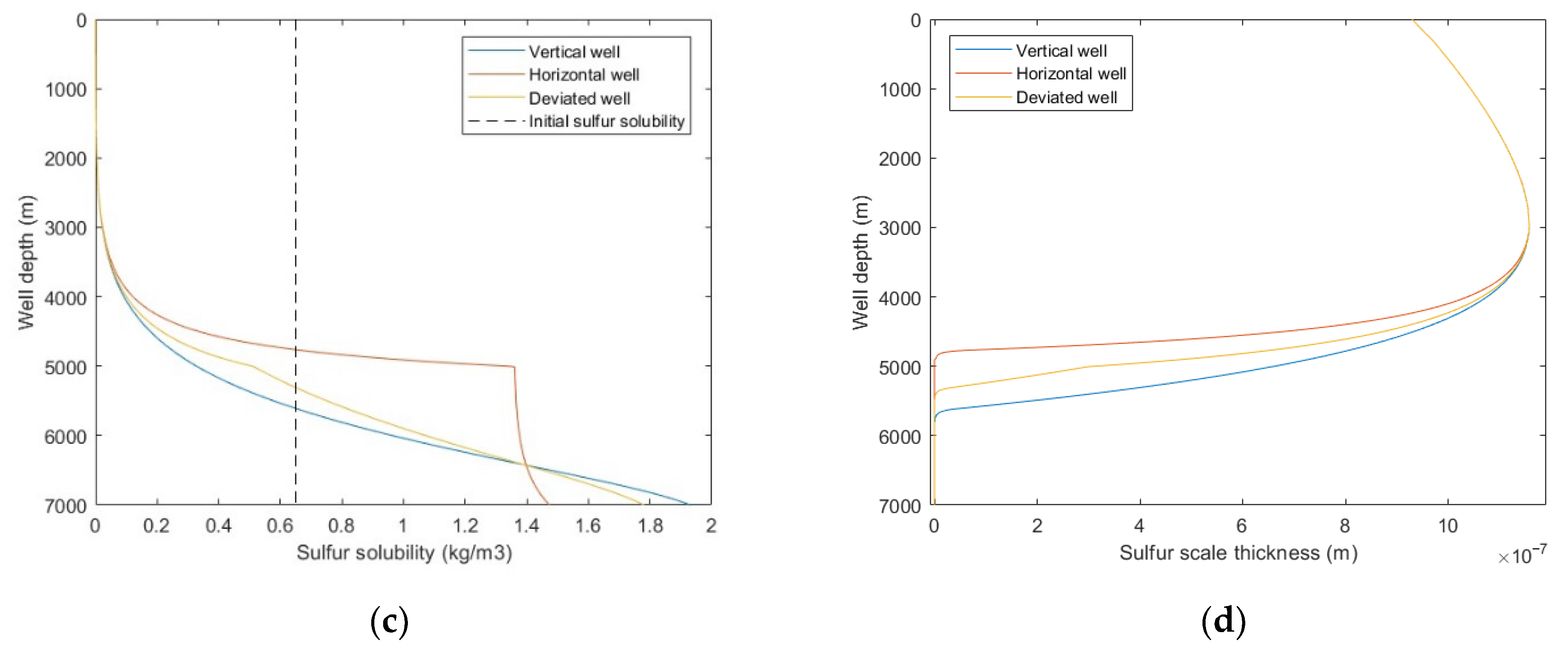
| Well Parameters | Natural Gas Main Components (%) | ||
|---|---|---|---|
| Wellhead pressure (MPa) | 30.33 | CH4 | 83.0 |
| Bottomhole temperature (°C) | 122.2 | C2H6 | 1.5 |
| Geothermal gradient (°C/m) | 0.024 | C3+ | 0.5 |
| Gas production (104 m3/d) | 1.62 | H2S | 10.4 |
| Well depth (m) | 4275.4 | CO2 | 4.6 |
| Parameters | Calculated Value | Measured Value | Relative Error (%) |
|---|---|---|---|
| Wellhead temperature (°C) | 21.6 | 22.4 | 3.46 |
| Bottomhole pressure (MPa) | 40.4 | 41.2 | 2.01 |
| Sulfur deposition location (m) | 3440.0 | 3468.2 | 0.81 |
| Parameters | Value |
|---|---|
| Sulfur density (kg/m3) | 2070 |
| Gas density (kg/m3) | 130 |
| Friction coefficient | 0.1 |
| Diameter of sulfur particle (m) | 3.2 × 10−3 |
| Well Parameters | Well A | Well B | Well C | Well D |
|---|---|---|---|---|
| Well type | Vertical well | Horizontal well | Deviated well | Deviated well |
| Wellhead pressure (MPa) | 17.34 | 25.6 | 16.66 | 22.77 |
| Bottomhole temperature (°C) | 143.81 | 154.55 | 148.72 | 152.29 |
| Geothermal gradient (°C/m) | 0.021 | 0.021 | 0.021 | 0.021 |
| Gas production (104 m3/d) | 24.2 | 8.0 | 64.0 | 28.6 |
| Well depth (m) | 6740 | 7180 | 6805 | 6963 |
| Kickoff point (m) | / | 6080 | 5920 | 6375 |
| Inclination angle (°) | 0 | 90 | 45 | 37 |
| Components (%) | Well A | Well B | Well C | Well D |
|---|---|---|---|---|
| CH4 | 88.817 | 90.391 | 90.554 | 87.774 |
| C2H6 | 0.036 | 0.031 | 0.027 | 0.033 |
| C3+ | 0.004 | 0.006 | 0.009 | 0.003 |
| CO2 | 5.093 | 4.152 | 3.614 | 5.247 |
| N2 | 0.224 | 0.448 | 0.427 | 0.338 |
| H2S | 5.826 | 4.946 | 5.336 | 6.592 |
| H2 | 0 | 0.010 | 0.001 | 0 |
| He | 0 | 0.016 | 0.032 | 0.013 |
| Total | 100 | 100 | 100 | 100 |
| Parameters | Well A | Well B | Well C | Well D |
|---|---|---|---|---|
| Calculated bottomhole pressure (MPa) | 25.96 | 36.95 | 25.12 | 34.11 |
| Measured bottomhole pressure (MPa) | 25.12 | 34.39 | 24.88 | 33.21 |
| Relative error (%) | 3.25 | 6.93 | 0.97 | 2.63 |
| Calculated wellhead temperature (°C) | 41.38 | 23.87 | 73.27 | 52.93 |
| Measured wellhead temperature (°C) | 41.50 | 25.60 | 73.90 | 56.50 |
| Relative error (%) | 0.28 | 7.25 | 0.87 | 6.75 |
| Well Parameters | Vertical Well | Horizontal Well | Deviated Well |
|---|---|---|---|
| Well depth (m) | 7000 | 7000 | 7000 |
| Kickoff point (m) | / | 5000 | 5000 |
| Inclination angle (°) | 0 | 90 | 45 |
Publisher’s Note: MDPI stays neutral with regard to jurisdictional claims in published maps and institutional affiliations. |
© 2022 by the authors. Licensee MDPI, Basel, Switzerland. This article is an open access article distributed under the terms and conditions of the Creative Commons Attribution (CC BY) license (https://creativecommons.org/licenses/by/4.0/).
Share and Cite
Guo, X.; Wang, P.; Ma, J.; Jia, C. Numerical Simulation of Sulfur Deposition in Wellbore of Sour-Gas Reservoir. Processes 2022, 10, 1743. https://doi.org/10.3390/pr10091743
Guo X, Wang P, Ma J, Jia C. Numerical Simulation of Sulfur Deposition in Wellbore of Sour-Gas Reservoir. Processes. 2022; 10(9):1743. https://doi.org/10.3390/pr10091743
Chicago/Turabian StyleGuo, Xiao, Pengkun Wang, Jingjing Ma, and Changqing Jia. 2022. "Numerical Simulation of Sulfur Deposition in Wellbore of Sour-Gas Reservoir" Processes 10, no. 9: 1743. https://doi.org/10.3390/pr10091743





